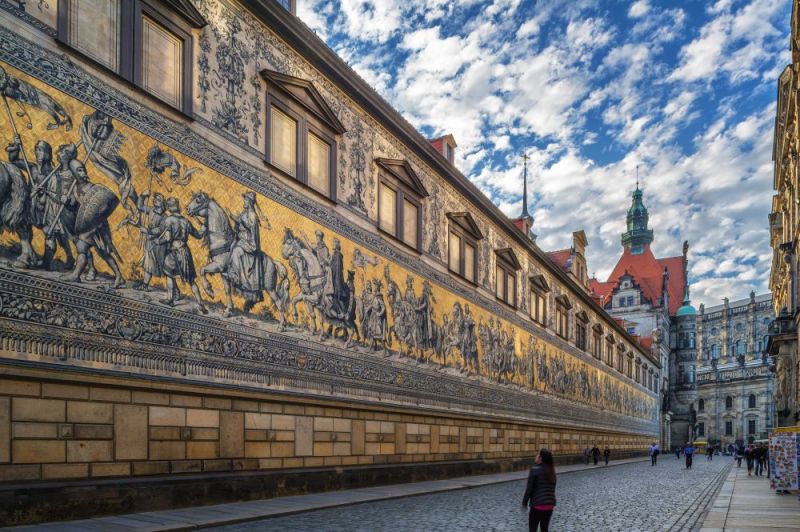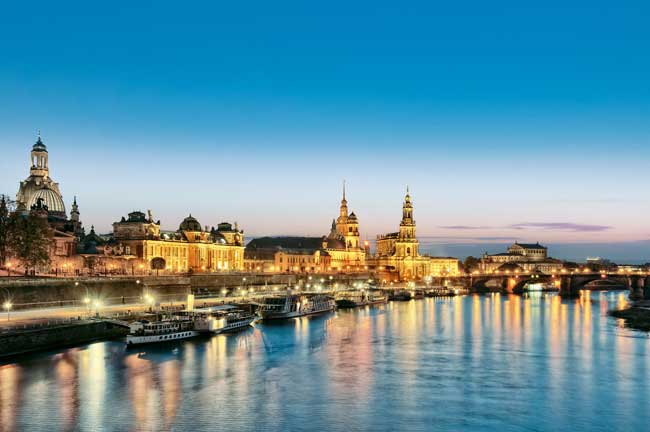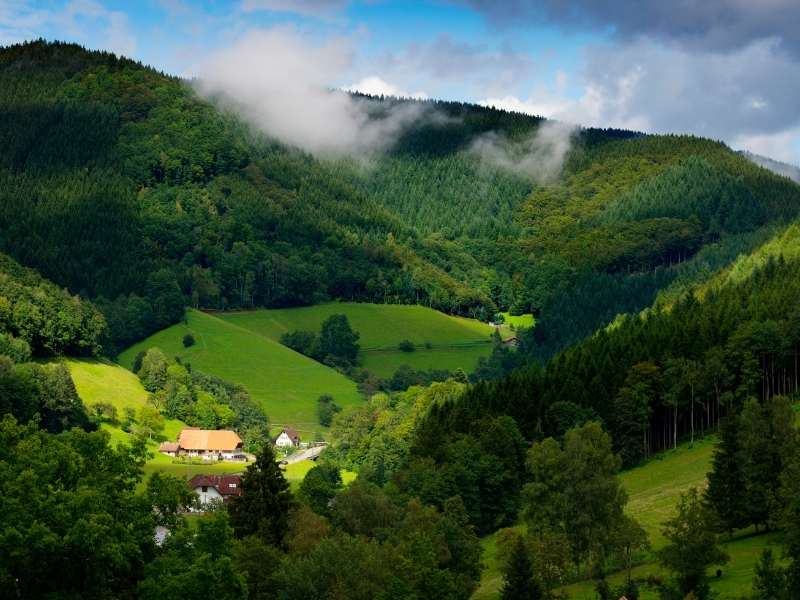Visit Dresden – Germany’s precious pearl
Dresden is the capital city of the Free State of Saxony, located in East Germany. It is an important economic and educational center of Germany. In this article, let’s learn more about Dresden, famous entertainment venues, and outstanding schools here with My Career Vietnam.
General introduction to Dresden city
With a population of approximately 560,000, Dresden is the second largest city in the state after Leipzig and the 12th largest city in Germany by population. Dresden is the seat of the Saxony state government and the Saxony state parliament, as well as many state agencies. Dresden is also the political center of the state of Saxony. In addition, the state’s important educational and cultural institutions are concentrated here.

Dresden is just a short drive from Berlin and is known as the “Florence of the Elbe”. Famous for its Baroque architecture and world-famous art treasures, it is so picturesque that you might not realise that 80% of Dresden’s historic centre was destroyed during World War II. The landmarks have since been rebuilt to their former glory.
Innovation and cutting-edge technology play an important role in the Dresden region, with information technology and nanoelectronics being economically significant. The pharmaceutical, cosmetics, machinery, vehicle and plant, food, optical, service, trade and tourism industries also generate significant added value in the Dresden city region. With three motorways, two long-distance railway stations, an inland port and an international airport, Dresden is also an important transport hub.
Geographical location and climate of Dresden city
Dresden lies on both banks of the Elbe River, mainly in the Dresdner Elbtal Weitung valley, between the lower part of the Ost Erzgebirge mountain range on one side and the steep walls of the Lausitz granite and the Elbsandsteingebirge sandstone mountains on the other. Known as Florence on the Elbe, Dresden is famous for its Mediterranean-inspired baroque architecture set in a picturesque natural setting.
After the expansion of the cadastral area, Dresden has 63% green area and is one of the greenest cities in Europe. The city has many nature reserves, especially the Dresden Valley with a length of 20 km, recognized by UNESCO as a World Cultural Heritage with the purpose of preserving the cultural and natural values of this area.
Dresden has a humid climate in the cool temperate zone and is influenced by continental climates. The settlements are concentrated in the valleys where the climate is different from the areas on the slopes or in the hills nearby. For example, the Klotsche area near the city’s airport, where there is a weather station and at an altitude of 227 metres above sea level, is always 1–2 °C cooler than in the centre.
Famous tourist attractions in Dresden city
Frauenkirche Cathedral
This is the tallest building and the symbol of the beautiful city of Dresden. This church was destroyed during World War II and was restored in 1994 with contributions from people all over the world.

Zwinger Palace
It is one of the most exquisite and beautiful Baroque and Rococo palaces in the world. In the early 18th century, King August der Starke, after traveling around Europe and admiring the unique architectural works, ordered the architect to build a luxurious and beautiful palace, Zwinger. Currently, the palace is home to many major art museums in Germany.

Bảo tàng Green Vault
This is one of the largest jewelry museums in Europe, preserving more than 4,000 precious artifacts. The most prominent is the extremely sophisticated “Golden Coffee Set”.

Fürstenzug Wall
The world’s largest porcelain painting, built to celebrate the 800th anniversary of the Wettin dynasty. The painting depicts 35 kings of Saxony.

Elbe River
Visiting the legendary historic river of Dresden is an experience that any foreign tourist must try when coming here. Currently, Dresden still has 9 of the oldest and largest steamboats in the world operating to take tourists to enjoy the city’s scenery.

Education in Dresden
Famous University System in Dresden
Dresden University of Technology
According to 2011 statistics, Dresden University of Technology (Technische Universität Dresden) with over 36,000 students, was founded in 1828 and is one of the oldest and largest universities of technology in Germany. It is currently the university with the largest number of students but also offers many courses in social studies, economics and other non-technical sciences. Dresden University of Technology has been successful in the German Universities Excellence Initiative of the Federal Ministry of Education and Research
Dresden University of Applied Sciences
Dresden University of Applied Sciences (Hochschule für Bildende Künste Dresden) was founded in 1992 and had about 5,300 students according to 2005 statistics.
Dresden Academy of Fine Arts
Founded in 1764 and known for its former professors and artists such as George Grosz, Sascha Schneider, Otto Dix, Oskar Kokoschka, Bernardo Bellotto, Carl-Gustav Carus, Caspar David Friedrich and Gerhard Richter.
Palucca Dance School
The Palucca Dance School (Palucca Hochschule für Tanz) was founded by Gret Palucca in 1925 and is a major European free dance school.
Other universities include: Carl Maria von Weber College of Music founded in 1856, Dresden International University is a private postgraduate university, founded in 2003 in cooperation with Dresden University of Technology.
Vocational training in Germany in Dresden city
Dresden is one of the cities with a large number of international students studying vocational training in Germany. One of the reasons is that the city has a healthy lifestyle, lots of trees, attractive tourist attractions along with the development of service industries such as restaurants, hotels, cooking, food… along with a cheap cost of living but a good vocational training allowance.
Some popular vocational study abroad programs in Dresden that you can refer to:
Hotel and restaurant kitchen industry
- Typical allowance: 850 – 1100 eu/month first year
- Food allowance: 150 eu/month
- Free housing available
Nursing
- Common allowance: 1000 eu/month and above first year
In addition to the popular majors above, if you want to study other professions in Dresden, you can contact My Career Vietnam.
Economy in Dresden
From 1990 to 2010, Dresden’s unemployment rate fluctuated between 13% and 15%, but has since fallen significantly. As of December 2019, the unemployment rate was 5.3%, the fourth lowest among Germany’s 15 largest cities (after Munich, Stuttgart and Nuremberg). In 2017, Dresden’s GDP per capita was 39,134 euros, the highest in Saxony.
Dresden’s proportion of highly qualified workers is among the highest in Germany and by European standards thanks to the presence of public administration centers, semi-public research institutes and the expansion of state-funded high-tech sectors.
In 2019, Dresden had the 7th best future prospects of all German cities, after being ranked 4th in 2017. According to a 2019 study by Forschungsinstitut Prognos, the city of Dresden is one of the most dynamic regions in Germany. It ranked 41st out of 401 German regions and 2nd among all regions in the former East Germany.
3 main sectors that dominate the economy of Dresden
- Semiconductor industry
- Pharmaceutical industry
- Mechanical and Electrical Engineering
Explore Dresden in depth – The ancient peaceful city
It is difficult to find a city in Germany that combines the beauty of contemplation and bustle, the natural beauty and the man-made products of wonderful Baroque architecture like Dresden. Let’s explore more about this unique city.
Khu Altstadt
Located in a city of Dresden with Neustadt side extremely vibrant with modern life, Altstadt is quiet and strangely peaceful. Just passing the Elbe River, visitors will see the neighborhoods with ancient houses bearing the color of time along with precious bronze statues and unique Baroque architectural motifs.
Although much of the Altstadt was destroyed by war, it has now been largely restored with the hope of preserving some of its original appearance.
Famous places in the Altstadt area include: Semperoper Opera House, Zwinger area, Residenzschloss castle, Elbe riverbank, Brühlsche Terrasse square, Dresden Cathedral, and the wall of Residenzschloss.
Khu Neustadt
In contrast to the ancient Altstadt, the Neustadt area is always bustling with people. Neustadt also has ancient architecture, although not as many as Altstadt, it still attracts many tourists: the golden horseback riding statue of King August der Starke, Japanisches Palais – ceramic castle, Yenidze used to be a tobacco factory but is now used for display and exhibition activities…
Special locations of the Neustadt district: the bustling city center of Dresden ? Albertplatz,
Khu Wackerbarth Schloss
The area around the famous vineyards and wine production of Dresden city, visitors can use means of transportation such as long-distance buses or trains to enjoy the scenery on both sides of the road. This is the suburb of the city, so you not only come to an interesting place to learn about wine, but also discover a very private space and breathe fresh air with nature full of trees.
Khu Pillnitz Castle and Park
There are castles and green parks, take the bus to Schloss und Park Pillnitz, one of the ideal destinations for tourists when coming to Dresden city, this place is extremely poetic and airy, looking like a beautiful girl with long hair reflecting on the beautiful and peaceful Elbe river every day.
Frequently Asked Questions
What is the best time to visit Dresden?
The European climate is cold in winter and cool in summer, so no matter what time it is, you can always experience everything wonderful here in a different way.
Is it good to study vocational training in Dresden?
Dresden is one of the cities with a large number of international students studying vocational training in Germany. One of the reasons is that the city has a healthy lifestyle, lots of trees, attractive tourist attractions along with the development of service industries such as restaurants, hotels, cooking, food… along with a cheap cost of living but a good vocational training allowance.



